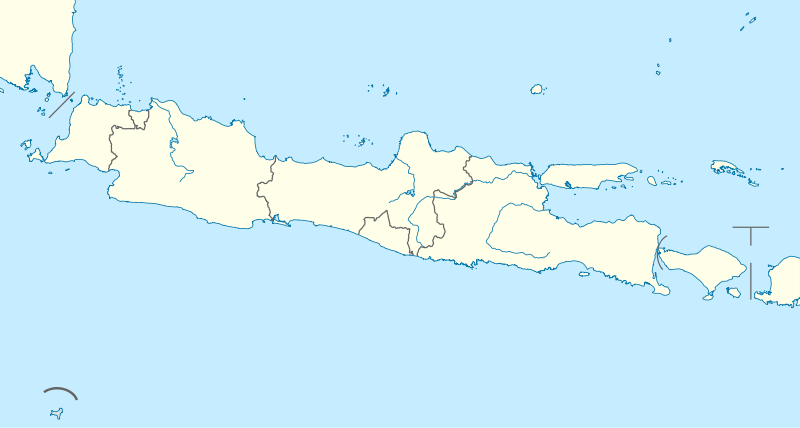Pawon
| Pawon | |
|---|---|
 | |
 Location within Java | |
| General information | |
| Architectural style | Buddhist candi |
| Town or city | near Magelang, Central Java |
| Country | Indonesia |
| Coordinates | 7°36′22″S 110°13′10″E / 7.60616°S 110.219522°E |
| Completed | circa early 9th century |
| Client | Sailendra |
Pawon (known locally as Candi Pawon) is a Buddhist temple in Central Java, Indonesia. Located between two other Buddhist temples, Borobudur (1.75 km (1.09 mi) to the northeast) and Mendut (1.15 km (0.71 mi) to the southwest), Pawon is connected with the other two temples, all of which were built during the Sailendra dynasty (8th–9th centuries).[1] Examines the detail and style of its carving this temple is slightly older than Borobudur.
The three temples were located on a straight line, suggesting there was a symbolic meaning that binds these temples.



"Between Mendut and Borobudur stands Pawon temple, a jewel of Javanese temple architecture. Most probably, this temple served to purify the mind prior to ascending Borobudur."
The original name of this Buddhist shrine is uncertain. Pawon literally means "kitchen" in Javanese language, which is derived from the root word awu or dust. The connection to the word "dust" also suggests that this temple was probably built as a tomb or mortuary temple for a king.[3] Pawon from the word Per-awu-an (place that contains dust), a temple that houses the dust of cremated king. However who was the personage that entombed here is still unknown. Local people name this temple as "Bajranalan" based on the name of the village. Bajranalan is derived from the sanskrit word Vajra (thunder or also a Buddhist ceremonial tool) and Anala (fire, flame).
In the contemporary era during the full moon in May or June, Buddhists in Indonesia observe Vesak annual ritual by walking from Mendut passing through Pawon and ends at Borobudur.[4]
Architecture
The temple slightly faces northwest and stands on a square base. Each sides of the stairs and the top of the gates are adorned with carved Kala-Makara, commonly found in classic Javanese temples. The outer wall of Pawon is carved with reliefs of boddhisattvas and taras. There are also reliefs of kalpataru (tree of life), flanked between Kinnara-Kinnari. The square chamber inside is empty with a square basin in the center of it. Rectangular small windows were found, probably for ventilation.
The roof section of is crowned with five small stupas and four small ratnas. Because of its relative simplicity, symmetry and harmony, the historians dubbed this small temple as "the jewel of Javanese temple architecture", in contrast with tall-slender East Javanese style counterparts as founds in later Singhasari and Majapahit period.
See also
References
- ↑ J. L. Moens (1951). "Barabudur, Mendut en Pawon en hun onderlinge samenhang (Barabudur, Mendut and Pawon and their mutual relationship)" (PDF). Tijdschrift voor de Indische Taai-, Land- en Volkenkunde. Het Bataviaasch Genootschap van Kunsten en Wetenschappen: 326–386. Archived from the original (PDF) on August 10, 2007.
trans. by Mark Long
- ↑ Yazir Marzuki, Toeti Heraty (1982). "Borobudur", pp. 6, Penerbit Djambatan. Jakarta. ISBN 979-428-078-X.
- ↑ Soetarno, Drs. R. second edition (2002). "Aneka Candi Kuno di Indonesia" (Ancient Temples in Indonesia), pp. 103. Dahara Prize. Semarang. ISBN 979-501-098-0.
- ↑ "The Meaning of Procession". Waisak. Walubi (Buddhist Council of Indonesia). Retrieved 2006-12-13.
| Wikimedia Commons has media related to Candi Pawon. |